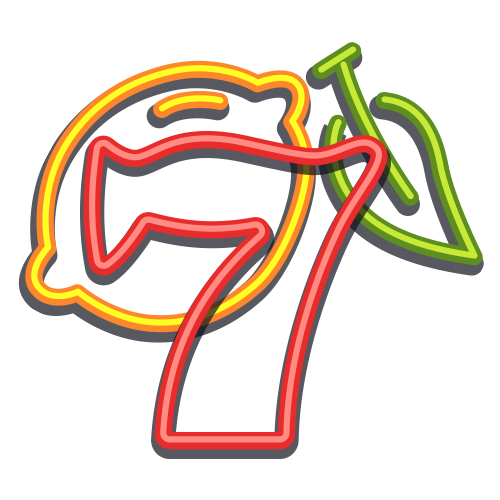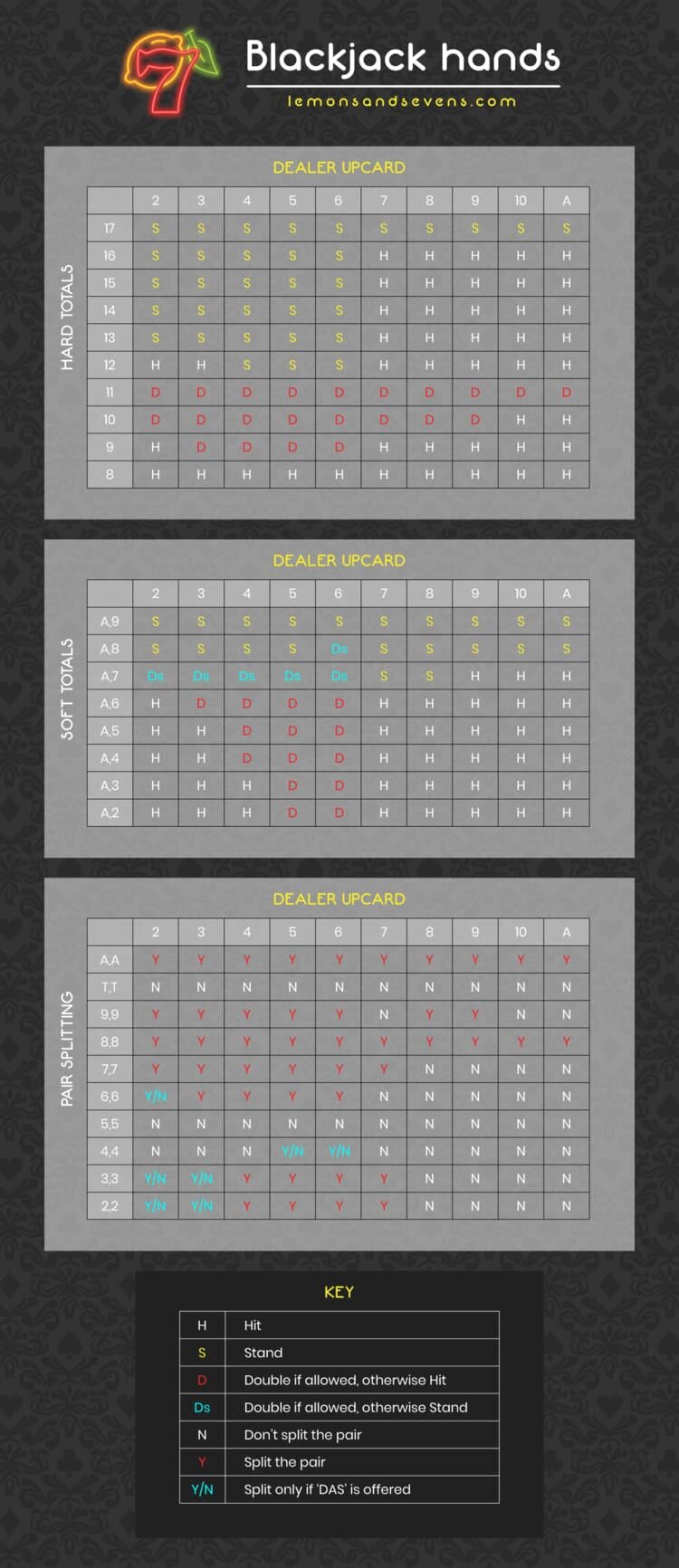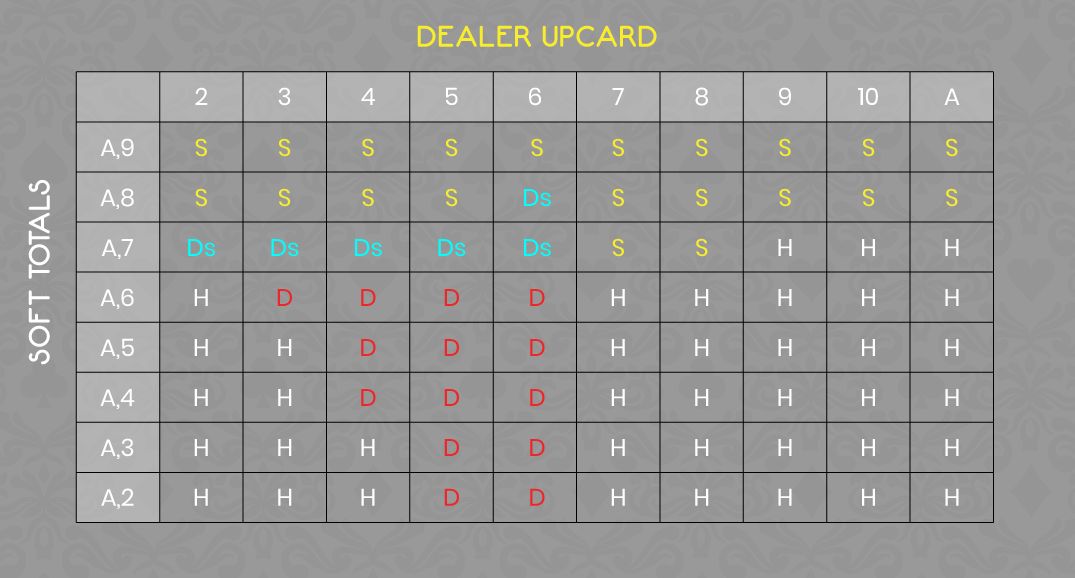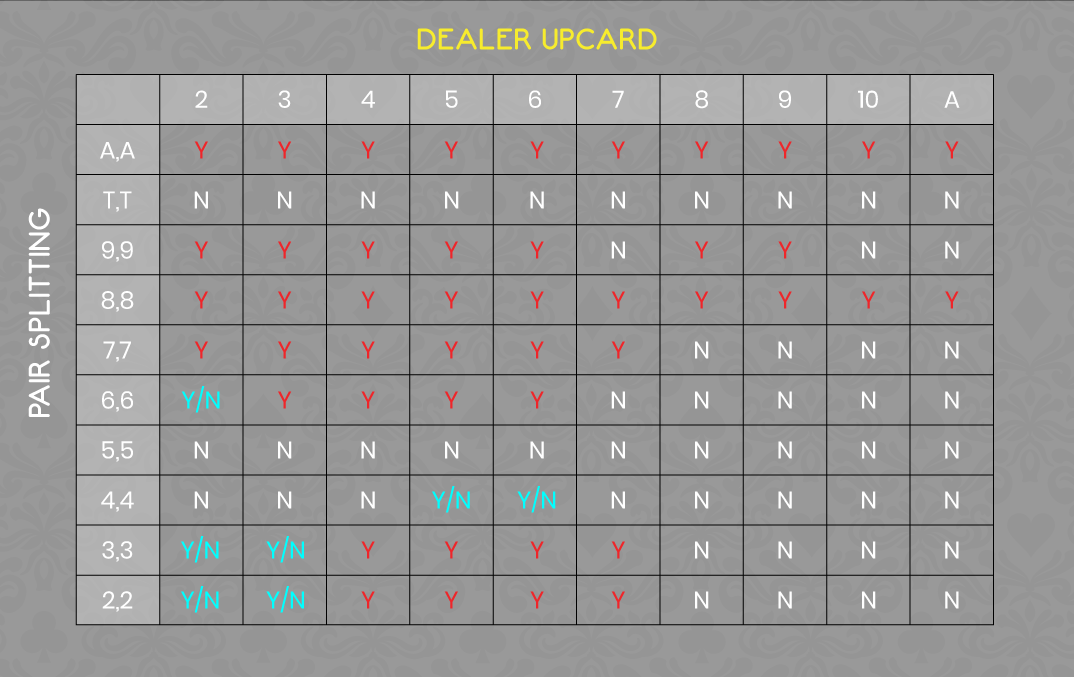Basic Blackjack Strategy Guide
Blackjack is the classic casino card game: you’ll find it in every casino and online. However, with all the blackjack terminology and fast-moving hands, new players can be intimidated out of playing blackjack at all. Worry not, at Lemons & Sevens we’ve set out to create the most simple guide to playing blackjack you’ll find on the internet.
(Really, we’ve searched far and wide, and there’s no simple guides to blackjack out there. So if you’ve been feeling overwhelmed by the sheer length of most blackjack guides, you’re in the right place. We’ve got nothing but the basics for you here.)
Blackjack strategy chart
Here’s your basic blackjack strategy cheat sheet. If you’re wondering how to use it (or what on earth Ds means), then keep scrolling for more blackjack tips for beginners.
What is blackjack?
Blackjack, also known as 21, is a game played against the dealer (rather than other players). The aim is to get as close to 21 as possible without going over.
If you go over 21, you will automatically bust. If you get a lower score than the dealer does, you will lose. It’s as simple as that!
There’s a bit more nuance to playing blackjack, as you might have guessed, so we’ll cover it as simply as possible below. (And again, don’t forget to check out our free blackjack cheat sheet if you just want to cut right to the chase.)
How to play blackjack
You can play blackjack online or in the casino, and our strategy card can be used for either. (Check out our Sky Casino blackjack review for more online blackjack coverage.)
This isn’t a guide to counting cards, though if you want to learn more about that, you can check out this post on counting cards online. Instead, we’re just going to cover the basic blackjack rules and the mechanics of play.
At the beginning of the hand, the croupier will deal you two cards face up. The croupier will also deal him or herself two cards, but only one of these will be face up.
It’s worth noting that in basically every casino, the dealer has to stand on 17 or above (it’s literally a rule, they can’t deal themselves another card in this scenario). So if the dealer gets 17, 18, 19, or 20, you know they have to stand on those two cards.
You’ll see the dealer’s second card after you have decided whether to hit or stand on your first two cards.
It’s also important to know that the first two cards you’re dealt can add up to any number up to 21, so it is impossible to bust by going over 21 with your first two cards.
Blackjack card values
In blackjack, the cards don’t increase in value from 2-Ace. Instead, all numbered cards (2-10) are worth their numeric value, all face cards are worth 10, and Aces are worth either 11 or 1 - whichever gives you the highest value without busting.
So let’s break that down - here’s all the blackjack card values:
2, 3, 4, 5, 6, 7, 8, 9 and 10 are all worth the numerical value on the card
Jack, Queen, and King are also worth 10
Aces are worth either 1 or 11 (whichever gives you the highest number without busting)
So, let’s say you’re dealt a 3♠ 5♦. Your hand has a value of 8. (It’s worth noting that the suit of the cards you are dealt has no effect whatsoever on the game.)
When should you hit, and when should you stand?
Once you have your first two cards, you can then decide if you want to “hit” or “stand”. Here’s what that means:
Hit - Deal another card (in the hopes that you get closer to 21)
Stand - Keep the two cards you have (in the hopes that the dealer doesn’t get closer to 21 than you)
If you have two cards that add up to more than 12, and decide to “hit”, you run the risk of going over 21 and busting (in other words, losing). If you decide to “stand”, you run the risk of the dealer dealing another card to themselves and getting closer to 21 than you did (in other words, losing).
In our example, you hold 3♠ 5♦, for a value of 8. You can decide to stand, in the hopes that the dealer does not have higher than 8, or you can “hit”, and get another card to bring you closer to 21. What would be the right decision?
Well, in this instance, the highest value card you could be dealt as your next card (an Ace, for 11) would give you 19, so would not put you above 21 - it's a no-risk decision to hit.
However, if your next card came up as 7♠ you’d have 3♠ 5♦ 7♠ for a value of 15. If you choose to hit again, you could draw a card worth 7, 8, 9, or 10 and bust!
Alternately, if your next card was A♣, you’d now have 3♠ 5♦ A♣ for value of 19. That’s pretty close to 21, right? The only cards that improve your hand here is a 2 or another Ace, so your chances of improving are slim. Probably best to stand in this scenario.
This is where our blackjack strategy chart comes in handy, as it will help you to work out when it is a good decision to risk the odds of another card, and when you’re close enough to 21 that it becomes a good idea to stand. It’s all based on the probability of getting closer to 21 using the information you have to hand, and that’s really what blackjack basic strategy comes down to.
How to win at blackjack
Once you decide to stand on the cards you have, and the dealer gets 17 or above, or goes over 21 and busts, the hand is over and bets are paid out. Blackjack pays out 1:1, meaning you’ll get double your bet back if you win. For example, if you bet £1, you’ll get £2 back (your bet of £1, plus another £1).
Of course, if you deal two cards that equal 21 right away, then you don’t need to hit or stand, you’ve automatically got a blackjack, and you’ve won! What’s more, winning with a blackjack on your first two cards pays out a higher rate of 3:2. (So long as the dealer doesn’t also get a blackjack - in which case, you just get your bet back.)
The only way to win at blackjack with your first two cards is to get an Ace and a Face. So that would be any combination of an Ace with a King, Queen, Jack or 10.
Extra blackjack rules and side bets
There are a few additional rules and side bets in blackjack that you should know about if you want to start playing this classic game. Here are the most common blackjack side bets and features that you’ll find in most casinos.
Double down
In blackjack, you usually have the option to double down on your bet immediately after your two initial cards have been dealt. (There are some casinos where this isn’t the case, but typically you’ll always be able to.)
Doubling down works as a kind of “vote of confidence” in your bet. It allows you to double your bet, thus doubling the amount you can win.
However, once you have doubled your bet, you can only have one more card dealt to you, after which you are forced to stand on whatever cards you have.
You have to think strategically when it comes to choosing which cards to double down on in blackjack. (Or, you know, just check out the basic strategy guide.)
Insurance
When the dealer’s upcard is an Ace, you can take “insurance” against their next card giving them a blackjack. The amount that the insurance pays will vary, but is usually 2:1. If the dealer does get a blackjack, your insurance bet is paid off.
However, insurance is a bet that will never be a part of any standard blackjack strategy, as it is a losing bet.
Splitting in blackjack
If your first two cards give you a pair, you can split your hand. Splitting your hand means that you need to double your bet and split your two cards into what is now two separate hands. Each of these one-card hands will then be dealt a second card each and you can play them both as normal.
Double after split (DAS)
There are a few occasions in blackjack upon which you should double your bet after splitting your hand (if, of course, the casino allows you to - many casinos do not allow doubling after splitting in blackjack). This is called “Double After Split” (DAS) or “Double Down After Split” (DDAS).
This means that when you are dealt a pair, you split your hand (so you now have two hands) and then place an additional wager which is equal to your original bet. This only comes up in some situations, where you have good enough odds after splitting your hand that it makes sense to double your bet.
Blackjack basic strategy
Now, let’s take a look at how to use that blackjack basic strategy calculator [download link].
You’ll see the chart is split into three sections - the first section tells you what action to take with the value of your first two cards (your “hard total”) vs. the dealer’s “upcard” (the dealer’s card that you can see before you take your first action).
In the example below, your hard total is 14 - let’s say it’s 8♠ 6♠ - and the dealer’s upcard is a 9. The H in the relevant part of the grid means that your best move in this situation is to Hit (H).
If you had the same cards but the dealer’s upcard was a 3, then your best move would be to Stand (S).
You can also see that in this particular part of the chart, there’s a few rows with a D on them. This stands for Double, or “double down”, and it highlights when it makes sense for you to double your bet, as we explained above.
The second part of the chart tells you what to do with your first two cards in the event that one of them is an Ace (which can be worth either 1 or 11, remember?) - hands with an Ace in blackjack are called “soft totals”, because they’re harder to bust with.
For example, if you have A♦ 6♥, your hand is worth both 7, and 17. If you draw another card, say 9♣, the Ace can be counted as a 1 and your hand is worth 16, not 26.
The third part of the chart deals only with pairs. When you are dealt two cards of the same type, e.g. 9♥ 9♠, you have the option to split your hand and double your bet, essentially playing two hands, as described above. However, it’s not always a good idea to take this option when you are dealt a pair.
Luckily, this third part of the chart tells you whether or not you should split your hand when you get a pair.
In this third section of the chart, Y/N means you should only split if “double after split” is offered by that casino, otherwise, don’t split.
Blackjack strategies with Lemons & Sevens
Not had enough of blackjack yet? Check out our article on counting cards in online blackjack, or our review of Sky Casino’s blackjack offering.
Got a question? Get in touch on Twitter or Instagram, or find us on YouTube for more gambling guides.







